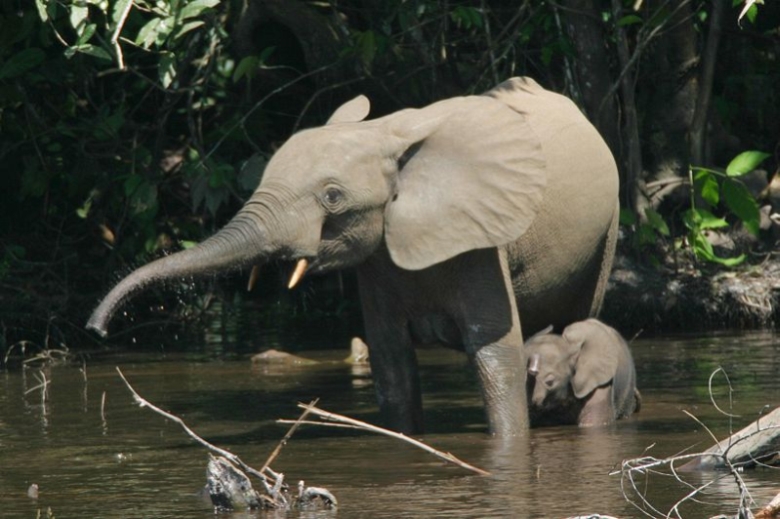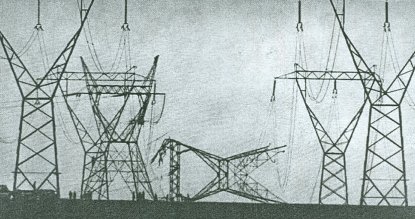
by Deep Green Resistance News Service | Mar 6, 2013 | Direct Action, Human Supremacy, Strategy & Analysis
Environmentalists today have our work cut out for us. Caught between the urgency of the ecological crises and reactionary capitalist forces that continue to push (quite successfully) for ever more outrageous and egregious destruction, finding an effective and timely path forward is no easy task. There are a wide variety of strategies for change vying for our attention, broadcast to us by a diversity of folks with a diversity of motivations—some of which are mixed, others confused, and more that are dangerous. By and large, the strategies we’ve adopted for our movements go unchallenged and unquestioned.
But given where we find ourselves—in the middle of an irredeemably exploitative and cruel society fundamentally dependent on fossil fuels—and what we’ve been able to accomplish so far in the fifty-some years of the environmental movement, it’s time to stop a moment and reflect.
What we’ve tried so far—everything from alternative consumer choices, lobbying, and symbolic protests to education, and localized permaculture lifeboats—has proven incapable of addressing the scale and severity of the crises at hand and ineffective in forcing change. While these tactics can be used to achieve certain goals, and certainly have their place within a serious movement for justice and sustainability, they will never be enough to accomplish what we must in the end.
So with that in mind, the time has come to have serious conversations and ask ourselves serious questions. What do we want to achieve, and how can we best achieve it?
Do we want to perpetuate a way of life that affords some of us with incredible material prosperity? Are we merely looking for new ways to sustain the unsustainable? Or do we want first and foremost to stop the destruction and exploitation of the living world, and are we prepared to adjust our society—our way of life—to what that requires of us? Are we prepared to see and name that destruction for what it is,industrial civilization, and do what’s necessary to bring a halt to it?
If so, are we willing to face what’s necessary to be successful? Are we willing to work for that goal by any means necessary, including sabotage and property destruction? Will we support those who do? For if the ends don’t justify the means, what does?
Are we willing to set the health of Earth as the ultimate metric by which we will be judged? As many others have said, those who come after us will not be swayed or moved by how deeply we ached at the world dying around us. They won’t forgive us no matter how big our marches and rallies were, nor how clever our slogans and chants. The precise harmony and abundance of our permaculture gardens will be irrelevant to them if the forests, rivers, and fish are gone. The spiritual fulfillment and inner peace we’ve found we be meaningless and resented if all the mountains have been ripped inside out, the air and water filled with poisons.
Fighting the good fight may satisfy us emotionally, but are we more concerned with emotional fulfillment or the health of the planet?
Either we win, and permanently put an end to this cancerous way of life—in no uncertain terms, dismantle industrial civilization—or it’s game over; baked topsoil devoid of bacteria and oceans empty of even plankton.
As all the tried and tired strategies, the benign, begging and ineffectual hopes for change fail repeatedly, are we prepared to take a new path? Are we willing, as a movement, to revisit our long-sworn oaths against direct action, sabotage, and property destruction? Are we left any other choice?
This is not an exhortation to action, not a dictate on what our tactics can or should be. And it’s certainly not an effort to incite you into doing anything you aren’t comfortable doing. This is an attempt to open the conversation, to humbly consider different strategies and tactics. Because what we’ve been doing so far isn’t working.
On the contrary, as a whole, the environmental movement is playing directly into the hands of the established systems of power. The solutions put forward by the mainstream fail to challenge industrialism, capitalism or civilization, and the mostly center around consumerism and economic growth—whether or not the planet survives is a moot point and is confined to the realm of rhetoric. The tactics proffered and peddled to us pre-packaged in marketing glitz and glamour will never be enough to carry us to our goals, because they refuse to confront and dismantle the material systems that are waging a relentless war against life. Instead, we plead with those in power, hoping in vain that they’ll change their hearts and minds.
But it is material systems—physical infrastructure of extraction and production—that are doing the deforesting, the strip mining, the fracking, the polluting, damming, the trawling; it’s not a few bad apples or an “unsustainable consciousness.” We can change hearts and minds until the sun burns out, but if we don’t confront and dismantle the structures of power that necessitates the devastation wreaked upon Earth by this culture, those compassionate hearts and minds will be irrelevant and quickly replaced by those better fitting the demands of the dominant power systems.
One measure of insanity is to do the same thing over and over and to expect different results. It’s long past time to admit that things aren’t changing; in the last 30 years, there hasn’t been a single peer-reviewed study that showed a living community that was improving or stable.
A recent study found that it’s twenty times more likely that climate change will be more extreme than forecasted than less extreme. Clearly what we’ve been doing isn’t working, or things would be getting better instead of worse (and the rate at which they’re getting worse is accelerating).
So where does that leave us? If the safe and fun strategies—the non-controversial and the convenient; the “green tech,” the lobbying, the consumer lifestyle choices—don’t work, what do we do? If we know it’s not working, how can we continue along the same path and expect anything different?
With so much—everything—at stake, will we collectively step over the line of comfort and safety that is afforded to us in exchange for our compliance and use whatever means necessary to stop the literal dismemberment of the planet’s life-support systems? If not us personally, will we support those who do?
When we look back in history we find countless examples of past movements facing near identical questions, and all too often they came to the decision that the use of physical force was necessary for fundamental change.
From the women’s suffrage movement which used arson against politicians who opposed the woman’s right to vote, to labor movements in the coal fields of Appalachia where miners battled company thugs. From the Black liberation struggles’ unabashed armed self-defense, to indigenous sovereignty struggles which employed militant land reclamations. From the ANC in South Africa and EOKA in Cyprus sabotaging electric transmission lines, to resistance forces across Europe during WWII attacking rail and transport infrastructures, and liberation movements around the world since using whatever means necessary to fight against colonialism. Strategic sabotage and other forms of militant action are proven to possess incredible potential for social movements to materially undermine the foundations of abusive power.
What will we do with that knowledge? How long will it take to decide, remembering that with every setting of the sun, another 200 species disappear from the world forever? Aren’t we overdue to have these conversations, to stop and ask these questions?
There isn’t any more time to be lost; we have lots of potential tools—tactics and strategies—available to us, and we need to put them all on the table, rather than limiting ourselves to least controversial (and least effective) among them. We need to accept the use of militant tactics, and support those who do. Strategic sabotage against industrial infrastructure has been used by countless movements to fight exploitation, and is undeniably effective.
When nothing else is succeeding in stopping the physical destruction of industrial society, can we finally accept militant action in defense of Earth as a viable option? With what’s at stake, can we afford not to?
Time is Short: Reports, Reflections & Analysis on Underground Resistance is a biweekly bulletin dedicated to promoting and normalizing underground resistance, as well as dissecting and studying its forms and implementation, including essays and articles about underground resistance, surveys of current and historical resistance movements, militant theory and praxis, strategic analysis, and more. We welcome you to contact us with comments, questions, or other ideas at undergroundpromotion@deepgreenresistance.org

by Deep Green Resistance News Service | Mar 6, 2013 | Climate Change
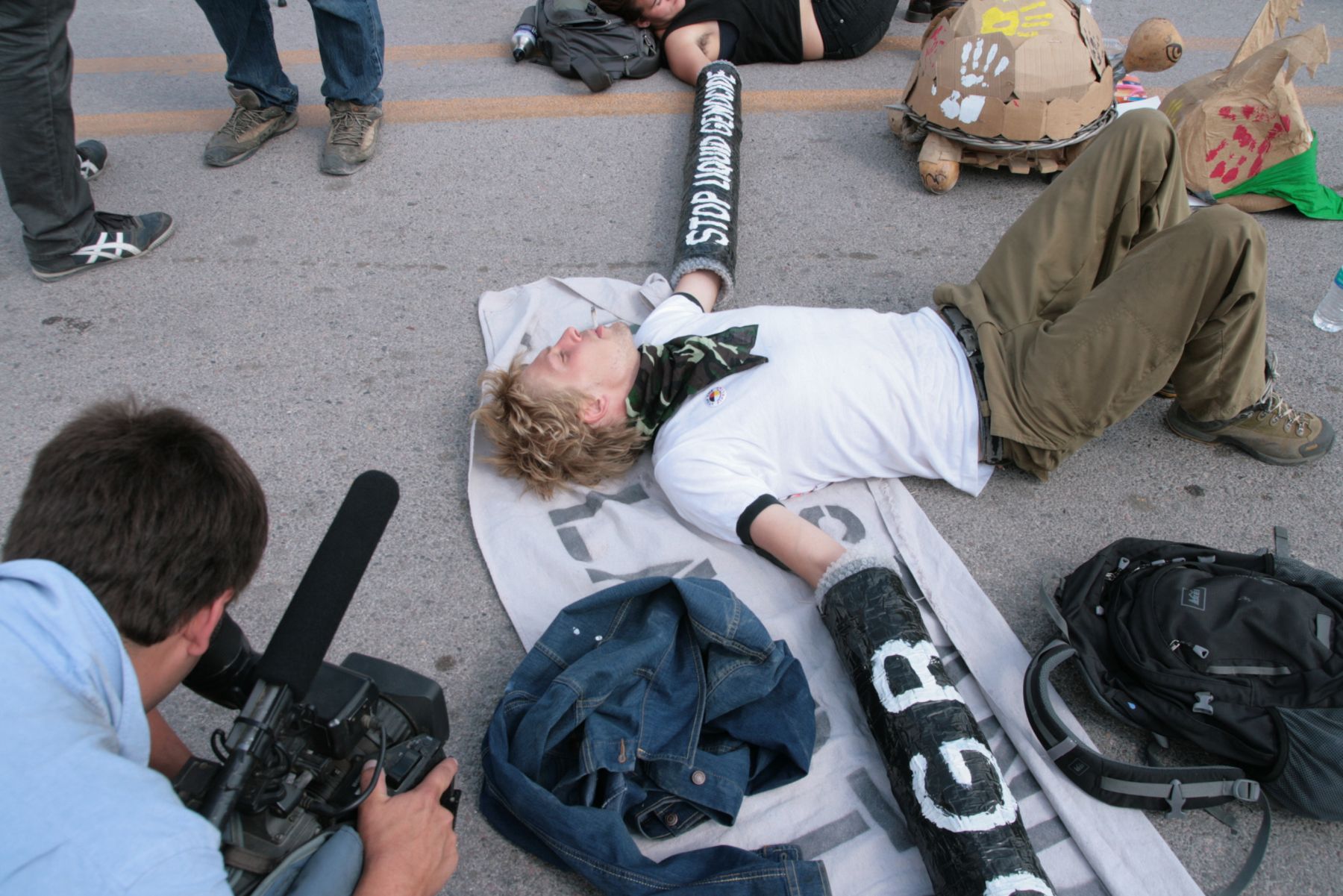
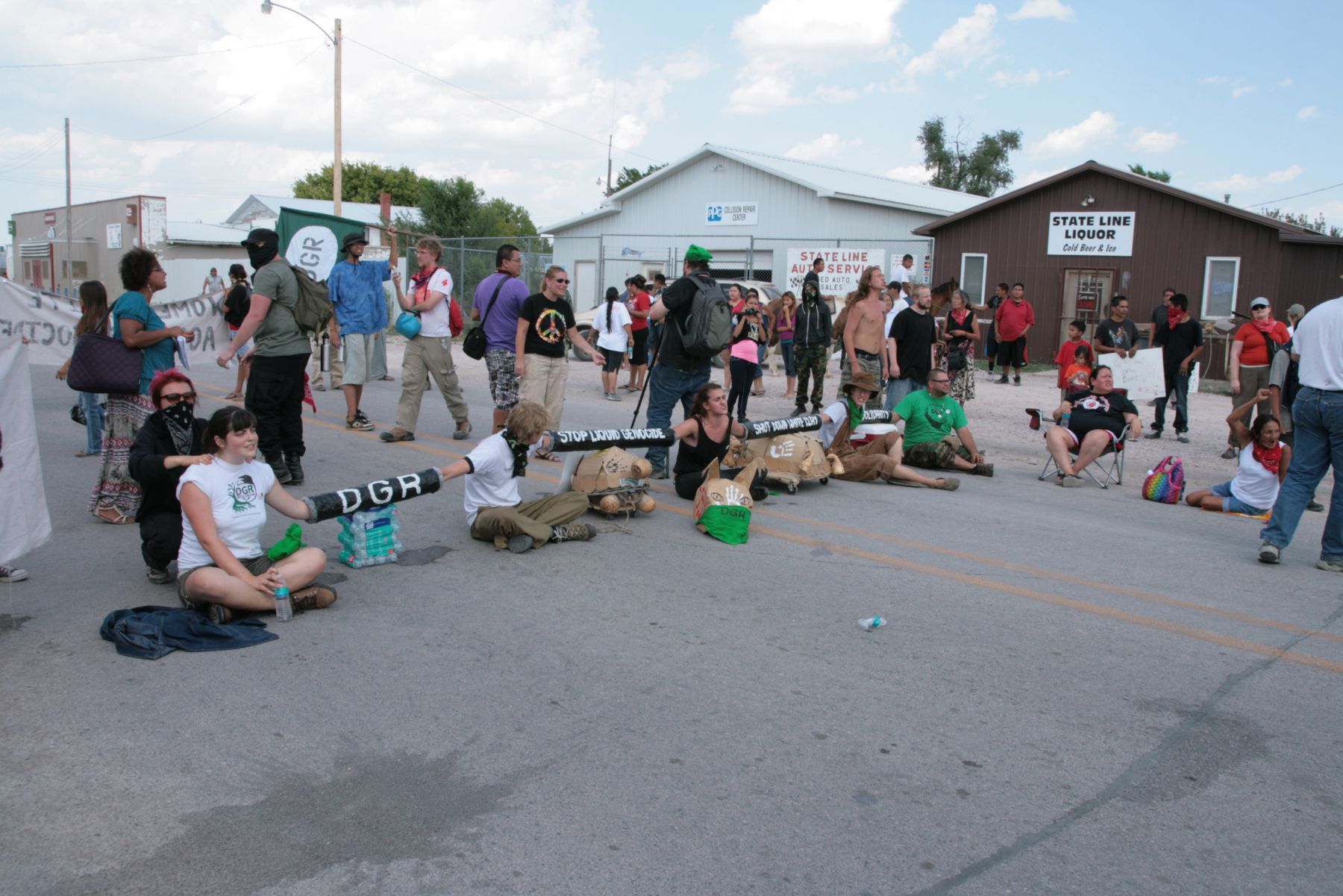

By Daniel Whittingstall / Deep Green Resistance Vancouver
The Situation and Our Options
Increased concentrations of atmospheric greenhouse gases (GHG), primarily carbon dioxide emitted from the burning of fossil fuels for cheap energy, have driven global average temperatures to rise. While this in itself is cause for concern, the real distressing predicament lies within the many positive feedbacks that are at or near their tipping points.
One major positive feedback is the arctic permafrost where large amounts of methane (a greenhouse gas) are stored underground. If the temperature continues to rise from the current 0.8C up to 1.5C above pre-industrial levels the permafrost will hit a tipping point and melt, releasing roughly 1,000 giga-tones of methane (which is 22 times more potent a greenhouse gas than C02 over a 100 yr. period, and 150 times more potent over a period of a couple years) into the atmosphere.
Since the global temperature is currently being raised due to Industrial Civilization’s increase of these GHG’s, and there is a time-lag between temperature rise and GHG levels (temperature catching up to where these gases have set the bar, roughly a 30 yr. time-lag), then all we need to do to find out how close we are to this tipping point is to look at current and historic levels of GHG’s and the correlating temperatures, right? Come walk with me for a moment.
Current C02 levels are at 395 ppm (C02 being the main factor in the last 180 yrs. of forcing temperature rise, most of which has increased in the past 30 yrs.). The last time C02 levels were this high was roughly 15 million years ago (mya), with temperatures roughly 3-6C above current levels (or 4-7C above pre-industrial times). It would be good to note here that projected emissions and C02 levels by 2030, if “business as usual” continues, will be around 516-774 ppm; levels closer to those of the Eocene 54-50 mya when temperatures were roughly 5-7C higher than today.
Since there is a time-lag between temperature rise and levels of C02 we can be certain that the temperature will rise 3-6C over the next 30 yrs. solely based on current levels of C02 alone. This of course would be the case without adding in any positive feedbacks like the melting of permafrost, arctic sea ice, ice caps, glaciers, ocean die offs due to acidification and rapid forest die offs due to drought/deforestation etc.
The thing is, the world has changed quite a bit in the last 15 myr. A lot more carbon, and other substances with the potential to turn into GHG’s, have been stored in the earths surface due to the resumption of glacial cycles (since 13 mya the earth has plummeted into glacial cycles-5 mya and rapid glacial cycles-2.5 mya), increasing the potential/possibility with which to warm the globe if they were ever to be fully released.
You see, the other tricky part about this time-lag is that if there was a huge spike in GHG’s over a shorter period of time, lets say 5-10 yrs. (which would definitely be the case if permafrost, ocean and forest die off positive feedbacks were to be pushed over their tipping points, thus releasing massive quantities of methane and C02), the global temperature rise would also increase at an exponential rate. Not to mention the fact that methane has a minute time-lag in comparison to C02.
So, a more realistic picture would be: current GHG levels will undeniably rise temperatures past the 1.5C mark in the next 10-15 yrs., pushing the permafrost over its tipping point and hurling it into a rapid positive feedback loop, drastically escalating the already exponential rate of global temperature rise. During (or even possibly before) this short process, every other positive feedback will come into play (this is because they are all just as sensitive to temperature and/or C02 increases as permafrost is) forcing the global temperature to rise beyond any conservatively or reasonably projected model.
What’s really concerning in all this is that the arctic sea ice, permafrost, glaciers and ice caps have already begun their near rapid melt, and we continue to increase our output of fossil fuel GHG emissions and deforest the earth. Does anyone know what more than a 5-7C temperature rise looks like? Near-term extinction for the majority of biological life, including humans. It means that almost all fresh and drinkable water will dry up. It means that the sea levels will rise by roughly 120 meters (394 ft). It means that the current levels of oxygen in the atmosphere right now will become so low that neither I nor you will be able to breath it. This is the part where most people start formulating rebuttals that usually include the word “alarmist!”. Well, if the bare facts of our current situation are not alarming then I would think we have an even bigger problem.
There are two distinct scenarios here that I feel need to be pointed out (most often they are not). The first one goes like this: if we keep destroying the Earth and continue down this path of “business as usual” then the biosphere will collapse and along with it the global economy and ultimately industrial civilization.
The other scenario goes like this: if the destruction perpetuated by industrial civilization is somehow halted, subsequently averting total biosphere collapse, then the global economy and industrial civilization will collapse.
Basically, in the next 10-15 yrs., it is unequivocal that either way the global economy and industrial civilization (all that we who are living within this structure know and rely on) will collapse.
Kind of makes the worry of a national economic recession seem like a bad joke. The question is then: which scenario would you prefer? The near extinction of all life on earth (including your own species), or the end of a really bad experiment in social organization that has almost, but not quite, destroyed the planet?
The only chance of survival is to immediately end the consumption of fossil fuels (on all levels and in every way, including well-intentioned “green-energy-solutions” that pump huge amounts of C02 into the atmosphere annually during set-up and production), and to quickly begin sequestering GHG’s from the atmosphere. Best way to end this consumption would be to shut down all fossil fuel extractions, and to lock up all ready-to-be-used fossil fuels: gasoline, coal, stored natural gas, and throw away the key. Best way to sequester the GHG’s (semi-naturally) would be to plant native-to-bioregional plants/trees wherever they had been destroyed, and to grow our own food locally in the parks, on roadways, on rooftops, and on the front/back lawns of every suburban home.
These are our only two options, and we need to do both at the same time. Realistically this means we will need to bring down atmospheric C02 levels to where they were in pre-industrial times. In order to have any certainty of success we must be 50% of the way there by about 2016, and 100% there by 2020.
Yes, things look bad. But it all depends on your perspective. One good thing is that civilization does not represent the whole of humanity, nor does it represent any other species of life on earth. So, on the one hand it doesn’t look too good for civilization if people decide to rise up and end this insanity (which would subsequently be a positive effect on the biosphere and the rest of humanity). But, on the other hand, well…not so good for anyone.
Nevertheless be encouraged, we still have a small window of time in which to succeed!
Overview of Data
Below are dates with projected increases of both C02 and global temperature, along with projected tipping points for major positive feedback loops around the world.
Reasonable Estimation of Temperature Correlation With C02 Levels
These calculations are based only on current levels of C02 and historic corresponding
temperature level values, no future increase of C02, no current or future positive feedbacks.
Current level of C02 395 ppm = 4.5C increase above current temp, average between 3-6C
(2013, 0.8C).
35 year time-lag = 2048 at 4.5C increase
Estimates For C02 Increase
C02 ppm increase at current rate, five year increments
| 2013 |
2018 |
2023 |
2028 |
2033 |
2038 |
2043 |
| 395 |
405 |
415 |
425 |
435 |
445 |
455 |
C02 ppm increase at current rate with increase of fossil fuel consumption and positive feedbacks
| 2013 |
2018 |
2023 |
2028 |
2033 |
2038 |
2043 |
| 395 |
415 |
435 |
455 |
495 |
535 |
575 |
Estimates For Temperature Increase
Temperature based on current trends over past 20 years (without further inputs)
| 2013 |
2020 |
2030 |
2040 |
2050 |
2060 |
| 0.80 |
0.90 |
1.05 |
1.20 |
1.35 |
1.50 |
Temperature increase based on C02 correlation/35 year time lag
| 2013 |
2018 |
2023 |
2028 |
2033 |
2038 |
2043 |
2048 |
| 0.80 |
1.33 |
1.86 |
2.39 |
2.92 |
3.45 |
3.98 |
4.51 |
Temperature increase based on C02 correlation and forcing from positive feedbacks
| 2013 |
2018 |
2023 |
2028 |
2033 |
2038 |
2043 |
2048 |
| 0.80 |
1.45 |
2.23 |
3.04 |
4.06 |
4.88 |
5.90 |
6.90 |
Note:
2050 Conservative estimates based on current trends for major tipping points
2018 Reasonable estimates based on C02 and positive feedbacks for major tipping points
2034 Average between both estimates for major tipping points
Individual Tipping Points for Positive Feedbacks
2016 1.11C increase -Arctic sea ice tipping point (warmer oceans)
2018 1.33C increase -Arctic clathrate tipping point (methane release)
2019 1.43C increase -Greenland and Antarctic ice sheet tipping points (sea level rise)
2020 1.54C increase -Permafrost tipping point (methane release)
2028 455ppm C02 -Ocean acidification tipping point (C02 release) 
Fig. 1. This shows the variations between projected increases in temperature: bottom line (brown) represents the rate of temperature increase based on the C02 correlation with a 35 year time lag, and top line (green) represents the temperature increase with C02 correlation including forcing from positive feedbacks.
Overview of Concepts in Climate Change
Carbon Dioxide
Carbon dioxide (CO2) is a naturally occurring chemical compound and is a gas at standard temperature/pressure. CO2 exists in Earth’s atmosphere as part of the carbon cycle, emitted through plant and animal respiration, fermentation of liquids, volcanic eruptions as well as various other means. Levels of CO2 concentrations have risen and fallen over the past 3 billion years but with striking clockwork over the last 800 thousand years, rising and falling on a cycle of 40-100 thousand years (Fig. 2).
Ice core data indicate that CO2 levels varied within a range of 180 to 300 ppm over the last 650 thousand years (Solomon et al. 2007; Petit et al. 1999), corresponding with fluctuations from glacial and interglacial periods, with the last interglacial period nearing levels of 290 ppm (Fischer et al., 1999).
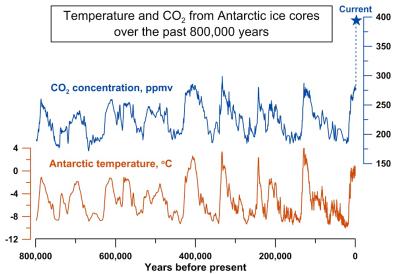
Fig. 2. This is a record of atmospheric CO2 levels over the last 800,000 years from Antarctic ice cores (blue line), and a reconstruction of temperature based on hydrogen isotopes found in the ice (orange line). Concentrations of CO2 in 2012, at 392 parts per million (ppm), from the Mauna Loa Observatory are shown by the blue star at the top (Simple Climate, 2012. Credit to: Jeremy Shakun/Harvard University). https://simpleclimate.wordpress.com/2012/04/04/global-view-answers-ice-age-co2-puzzle/
Near the end of the Last Glacial period, around 13,000 years ago, CO2 levels rose from about 180 ppm to about 260 ppm and leveled off until the Industrial Revolution in the mid 1700’s when it began to climb from 280 ppm (Neftel et al. 1985). While that 260 ppm of CO2 had remained more or less unchanged for the last 10,000 years, roughly since early Civilization, it was the actions of Civilization through the burning of fossil fuels, since the Industrial Revolution, that caused a dramatic increase over the last century (Blunden et al. 2012, S130).
The contribution of Industrial Civilization’s CO2 comes mainly from the combustion of fossil fuels in cars, factories and from the production of electricity and deforestation for timber and agricultural lands. Today the monthly mean concentration levels, (Fig. 3), are around 394 ppm (Recent CO2 readings for 2012 at the Mauna Loa Observatory by the National Oceanic & Atmospheric Administration), increasing about 100 ppm from pre-industrial times in just the last 100 years and currently rising at a rate of 2 ppm each year.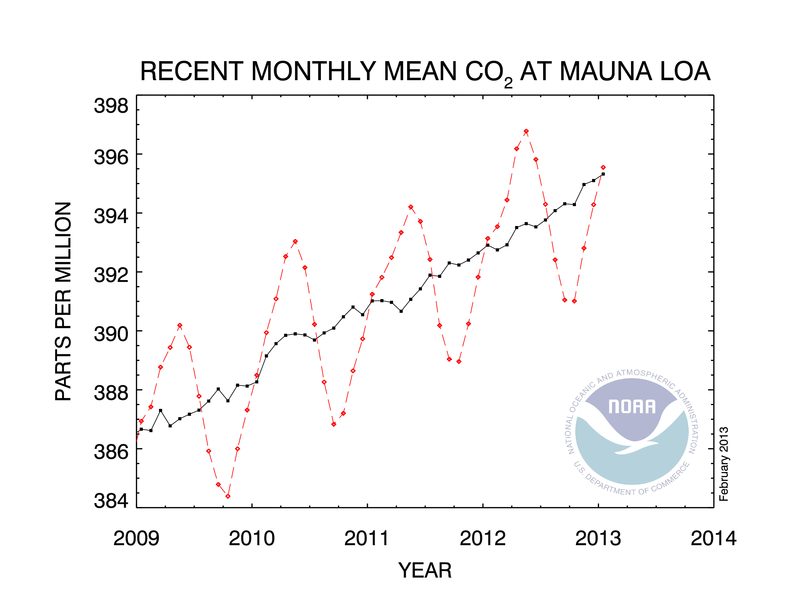
Fig. 3. This table shows monthly mean CO2 measurements for the years 2008 to 2012 from the Mauna Loa Observatory, Hawaii. The dashed red line represents monthly mean values, and the black line is representative of monthly mean values with the correction for average seasonal cycles (NOAA Earth System Research Laboratory, 2012). http://www.esrl.noaa.gov/gmd/ccgg/trends/#mlo_full
Carbon dioxide has a long lifespan once emitted into the atmosphere. “About half of a CO2 pulse to the atmosphere is removed over a time scale of 30 years; a further 30% is removed within a few centuries; and the remaining 20% will typically stay in the atmosphere for many thousands of years.” (Solomon et al. 2007).
Therefore, the amount of CO2 currently in the atmosphere will possibly be persisting long enough to mingle with future emissions that are projected to be higher. Based on CO2 emissions from burning fossil fuels in the year 2000, the IPCC calculated out the possible future increase of emissions if Civilization continued at that current rate of economic and consumer growth (increased fossil fuel consumption). “The projected emissions of energy-related CO2 in 2030 are 40–110 % higher than in 2000” (Solomon et al. 2007).
This could result in an increase of atmospheric CO2 from levels that were 369 ppm at the time, to 516-774 ppm by 2030 (Fig. 4); levels closer to those of the Eocene, 700-900 ppm roughly 54-50 million years ago (Paul N. Pearson 2000), when temperatures were about 5-7 degrees Celsius warmer than today and sea levels were roughly 120 m higher (Sluijs et al. 2008).
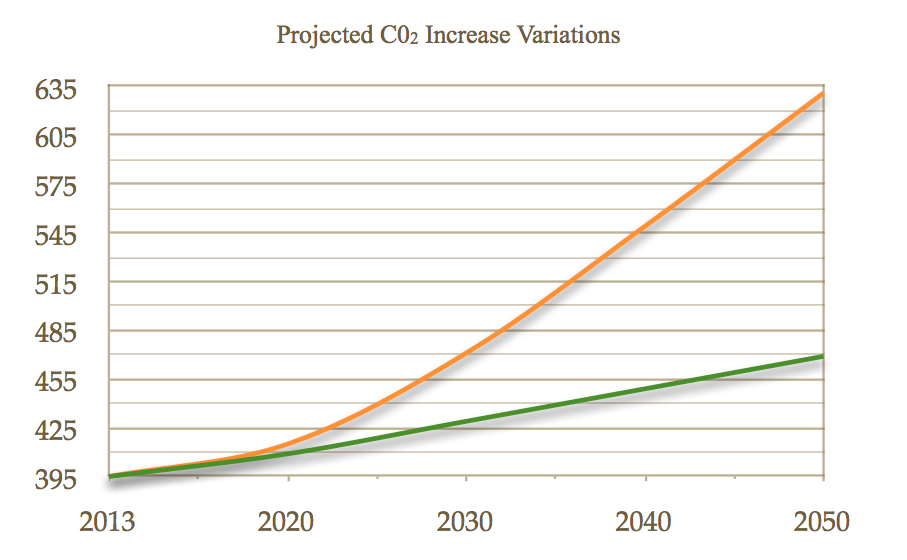
Fig. 4. This table shows the variations between projected C02 increases: bottom line (green) is the current rate of increase at 2ppm/yr. based on previous ten year average, top line (orange) is current rate plus increased Industrial Civilization forcing and positive feedbacks.
Greenhouse Earth
The environmental effects of carbon dioxide are of significant interest. Earth is suitable for life due to its atmosphere that works like a greenhouse. A fairly constant amount of sunlight strikes the planet with roughly 30 percent being reflected away by clouds and ice/snow cover, leaving the uncovered continents, oceans and atmosphere to absorb the remaining 70 percent. Similar to a thermostat, this global control system is set by the amount of solar energy retained by Earth’s atmosphere, allowing enough sunlight to be absorbed by land and water and transforming it into heat, which is then released from the planet’s surface and back into the air as infrared radiation.
Just as in the glass ceiling and walls of a greenhouse, atmospheric gasses, most importantly carbon dioxide, water vapor and methane, trap a fair amount of this released heat in the lower atmosphere then return some of it to the surface. This allows a relatively warm climate where plants, animals and other organisms can exist. Without this natural process the average global temperature would be around -18 degrees Celsius; see more (Solomon et al. 2007).
The current levels of greenhouse gas (GHG) concentrations, principally carbon dioxide (Fig. 3), in the Earth’s atmosphere today are higher and have the potential to trap far more radiative heat than has been experienced within the last 15 million years (Tripati 2009), amplifying the greenhouse effect and raising temperatures worldwide. “The total CO2 equivalent (CO2-eq) concentration of all long-lived GHG’s is currently estimated to be about 455 ppm CO2-eq” (Solomon et al. 2007), as of 2005. These other contributors of GHG’s include methane released from landfills, agriculture (especially from the digestive systems of grazing animals), nitrous oxide from fertilizers, gases used for refrigeration and industrial processes, the loss of forests that would otherwise store CO2, and from the melting of permafrost in the arctic.
According to the IPCC Fourth Assessment Report “These gases accumulate in the atmosphere, causing concentrations to increase with time. Significant increases in all of these gases have occurred in the industrial era”, and the increases have all been attributed to Industrial Civilization’s activities (Solomon et al. 2007).
Historically, through the rise and fall of temperatures over the last 800 thousand years, temperatures have risen first, then CO2 would increase, accelerating even more temperature rise until a maximum when both would then drop, creating a glacial period. Though CO2 levels over this period of time have not been the trigger for temperature rise and interglacial periods, they either have occurred at the same time or have led positive feedback global warming during the stages of deglaciation, greatly amplifying climate variations and increasing the global warming capacity due to the greenhouse effect (Shakun et al. 2012), (Solomon et al. 2007).
What makes the present situation unpredictable to some extent is that never before has CO2 climbed so rapidly and so high, far ahead of temperature. Furthermore, this extra heat-trapping gas released into the atmosphere takes time to build up to its full effect, this is due to the delaying effect of the oceans as they catch up with the temperature of the atmosphere; deep bodies of water take longer to warm. There is a twenty-five to thirty-five year time lag between CO2 being released into the atmosphere and its full heat-increasing potential taking effect.
This means that most of the increase of global temperature rise observed thus far has not been caused by current levels of carbon dioxide but by levels that already have been in the atmosphere before the 1980’s. What is troublesome here is that these last three decades since then have seen the levels of greenhouse gases increase dramatically. On top of the current temperature rise we see now there is already
roughly another thirty years of accelerated warming built into the climate system.
There are many other Civilizational factors that contribute to this global rise in temperature outside of GHG’s. While these extra factors do supply further warming and are just as serious a threat to a semi-stable climate, they are not as long lasting.
One of the most notable of these, being the second largest Civilizational contributor to global temperature rise, is black carbon (BC), also called soot (T. C. Bond et al 2013). The greatest sources of BC are the incomplete burning of biomass (forest and savanna burning for agricultural expansion) and unfiltered diesel exhaust for transportation and industrial uses (Ramanathan and Carmichael 2008). There is a two fold warming effect from the BC.
First, the dark particles of this soot absorb incoming heat from solar radiation and directly heat the surrounding air, though only for a short period of time. Secondly, the soot particles in the air, once carried from their point of origin, are increasingly falling on snow and ice changing these reflective surfaces into absorptive ones, decreasing the albedo (reflectivity). Therefore, BC deposits have increased the melting rate of snow and ice.The most alarming of these effects can be seen on glaciers, ice sheets and the arctic sea ice (T. C. Bond et al 2013). While reductions in BC would have immediate but not long lasting effects on temperature rise, it would increase the chances of averting further warming
Nevertheless, the projected rise due to the continued increase in levels of GHG’s will not be prevented without
reducing overall emissions.
Temperature
The Earth is warming and this time the trend is far from natural. The average temperature of the Earth’s surface has risen by 0.8 degrees Celsius since the late 1800s (Fig. 4). On a geologic timescale this swift increase is alarming. When temperatures have risen in the past, warming the planet at several points between ice ages, the average length of time this process has taken is roughly 5,000 years to increase global temperatures by 5 degrees.
In this past century alone the temperature has risen ten times the average rate of ice age recovery warming, a recent trend not only driven by the rise of atmospheric CO2 concentrations, but also amplified by them.

Fig. 4. This table shows global temperature anomaly from 1880 through to 2011. Black lines are representative of annual mean variances and the red line is representative of five year running temperature mean’s. (NASA Goddard Institute for Space Studies, 2012) http://data.giss.nasa.gov/gistemp/2011/Fig2.gif
Continued economic, global population and energy consumption growth over the next few decades will consequently increase not only CO2 emissions, but also the rate and quantity with which they accumulate in the atmosphere. This is a business-as-usual scenario where efforts to reduce greenhouse gas emissions, namely CO2, have fallen short of any earnest mitigation, “locking in climate change at a scale that would profoundly and adversely affect all of human Civilization and all of the world’s major ecosystems” (Allison et al. 2009); see scenario A1FI (Fig. 5).
Even if the global mean temperature only rises another 2 degrees before the end of this century, it would be a larger increase in temperature rise than any century-long trend in the last 10,000 years. A one degree global temperature rise is also significant for the reason that it takes a vast amount of heat to warm all the oceans, atmosphere, and land by that much; even more so is the significance of subsequent ecosystem collapse in climate sensitive areas such as the Arctic due to such a rise.

Fig. 5. This is a reconstruction of global average temperatures relative to 1800-1900 (blue), observed global average temperatures since 1880 to 2000 (black), and projected global average temperatures out to 2100 within three scenarios (green, yellow and red), (Allison et al. 2009). Scenario A1FI, adopted from the IPCC AR4 2007 report, represents projections for a continued global economic growth trend, and a continued aggressive exploitation of fossil fuels; the FI stands for “fossil fuel intensive”. http://www.ccrc.unsw.edu.au/Copenhagen/Copenhagen_Diagnosis_HIGH.pdf
Arctic Warming
The greatest changes in temperature over the last hundred years has been in the northern hemisphere, where they have risen 0.5 degrees Celsius higher since 1880 than in the southern hemisphere (Fig. 6). The Arctic is experiencing the fastest rate of warming as its reflective covering of ice and snow shrinks and even more in sensitive polar regions.
One of the main facets that are being affected by the increase of temperature in the Arctic is the potential collapse of Arctic ecosystems that succeed in the region. Ecosystems that are under pressure and that are at their tipping points can be defined as having their thresholds forced beyond what they can cope with. Different components of ecosystems experience diverse changes. In this instance,
“ecosystem tipping features” refers to the components of the ecosystem that show critical transitions when experiencing abrupt change (Duarte et al. 2012).
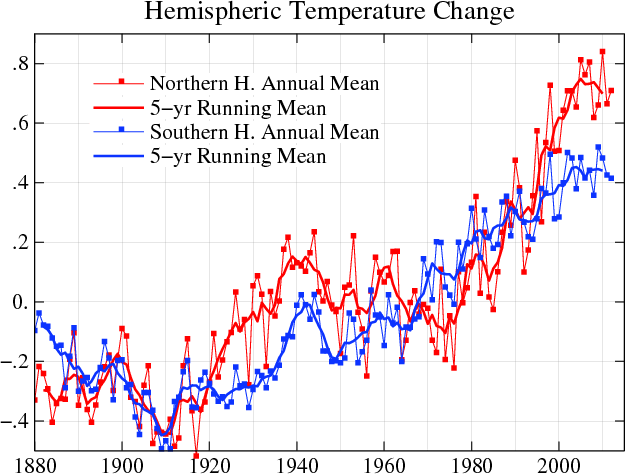
Fig. 6. This table shows both annual and five year mean temperature variances between 1880 and 2011. Temperature mean averages for the northern hemisphere are in red and southern hemisphere averages are in blue (NASA Goddard Institute for Space Studies, 2012). http://data.giss.nasa.gov/gistemp/graphs_v3/Fig.A3.gif
Sea Ice Loss
The significance of sea ice loss in the Arctic relates to a serious tipping point in the Arctic marine ecosystem which is given by the temperature at which water changes state from solid to liquid. Ice responds suddenly to changes at this temperature. This causes warming and loss of sea ice to amplify the potential changes to the climate including a reduction in albedo with the declining sea ice. Crossing the tipping point sets in motion many changes that further increases temperature in the Arctic region on top of current global warming (Duarte et al. 2012).
The ice that encompasses the Arctic has slowly been dwindling ever since a catastrophic collapse in the Arctic region in 2007. Since that point, close to two thirds of the ice has vanished compared to a decade earlier when the loss of sea ice was significantly smaller (Anderson, 2009). Scientists had previously predicted that the ice in the Arctic region would not be reduced to the point that it reached in 2007 until at least 2050, and in 2012 it dropped to levels much lower than in 2007 (Fig. 7). It is now predicted that the Arctic summer ice could disappear entirely as early as 2013.
The vulnerable setting of the Arctic region has certainly made it easy for global warming to have significant influences on the natural climate processes. The white ice naturally reflects sunlight back into space, but with the melting of the ice and subsequent open, dark sea water, the reflectivity is reduced and therefore the heat is retained instead. The arctic seas warm up, melting more ice, and then even more is absorbed and melted by the increasing water temperature change. This creates a dangerous feedback loop that intensifies melting and overall temperatures.
Observations and climate models are in agreement that through the 21st century, Arctic sea ice extent will continue to decline in response to fossil fuels being burnt and greenhouse gases being released into the atmosphere. Through the influxes of heat being circulated, temperature for the terrestrial and aquatic systems continues to increase, delaying ice growth during winter and autumn only to increase the temperature on the region.
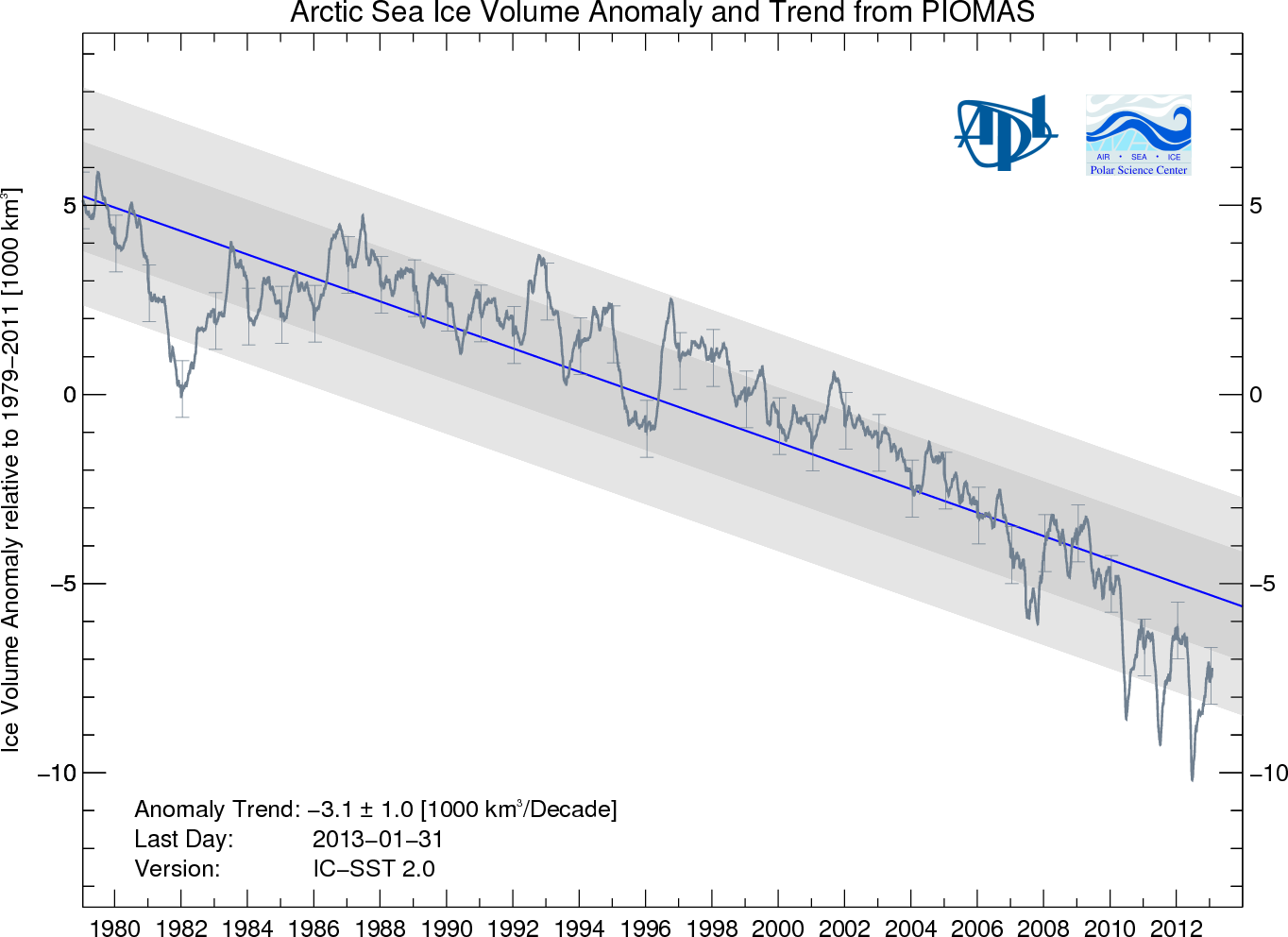
Fig. 7. This table shows the ice volume anomalies of the Arctic ocean, with respect to the volume of ice over a period between 1979 to 2011. (Polar Science Center, psc.apl.washington.edu. 2011) http://psc.apl.washington.edu/wordpress/wp-content/uploads/schweiger/ice_volume/BPIOMASIceVolumeAnomalyCurrentV2.png?%3C%3Fphp+echo+time%28%29
Permafrost Melt
One of the most worrisome scenarios of a positive feedback is the thawing of huge quantities of organic material locked in frozen soil beneath Arctic landscapes. Vast quantities of carbon and methane from once rotting vegetation are stored in the frozen soil. This frozen soil is called permafrost and it contains significantly more carbon than is currently in the atmosphere.
Permafrost is defined as subsurface Earth materials remaining below 0°C for two consecutive years. It is thoroughly widespread in the Northern Hemisphere where permafrost regions occupy 22% of the land surface (Schuur et al. 2008).
The temperature, thickness and geographic continuity of permafrost are controlled by the surface energy balance. Permafrost thickness geographically ranges from 1 meter to 1450 meters depending on where the permafrost is situated. The layer that thaws in the summer and refreezes in the winter is referred to as the active layer. The thickness of the active layer ranges between 10 centimeters and 2 meters. Beneath the active layer is the transition zone, the buffer between the active layer and the more stable permafrost. The thickness of the active layer is significant because it influences plant rooting depth, hydrological processes, and the quantity of organic soil matter uncovered to the above-freezing seasonal temperatures. The growing concern is that permafrost’s relationship with the Arctic warming could lead to drastic changes for the region.
The processes that involve the transfer of stored carbon into the atmosphere have the potential to significantly increase climate warming in the Arctic region (Schuur et al. 2008). Since it only would take a few more degrees in temperature rise to tip the permafrost into rapid thawing and subsequently release huge amounts of stored carbon and methane, methane being over 20x as potent a greenhouse gas, this would result in a much larger feedback into the global GHG level rise.
A Warmer World
Industrial Civilization is on a path to heat the Earth up by 4 to 7 degrees Celsius before the middle of this century if it fails to end its carbon emissions, triggering a cascade of cataclysmic changes that will include the increase of extreme heat-waves, prolonged droughts, intensified weather patterns, the total loss of Arctic sea ice, rapid decline in global food availability, sea level rise affecting billions of people, and eventually an abrupt extinction of the majority of biological life on earth.
The solution, while not a simple one to execute, is clear: Industrial Civilization must end its reliance on fossil fuels and begin to sequester CO2 from the atmosphere immediately, reducing the atmospheric concentration of CO2 down to a safe level.
A full reference list for this article is available here: http://dgrnewsservice.org/newsservice/2013/03/reference-material1.pdf
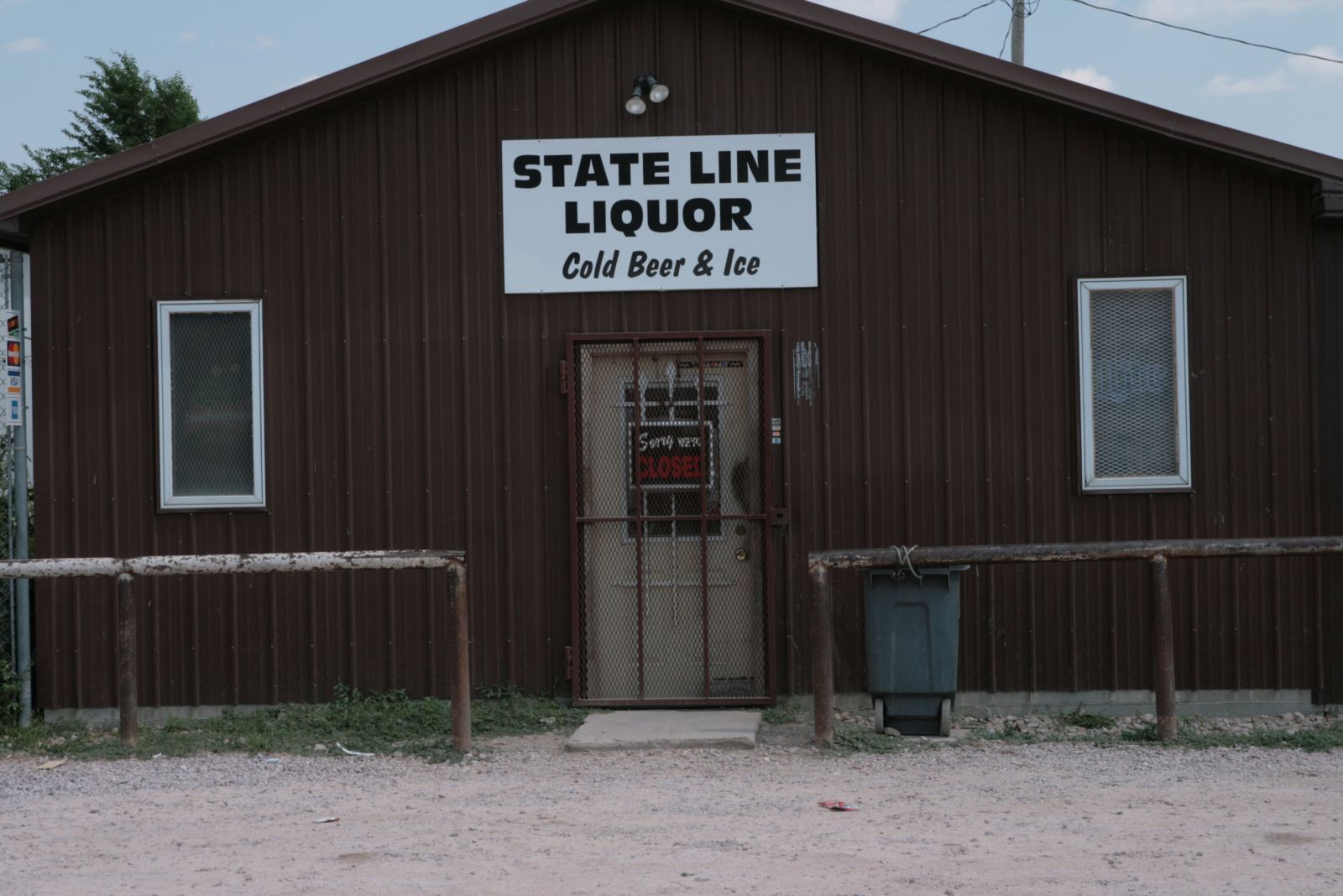
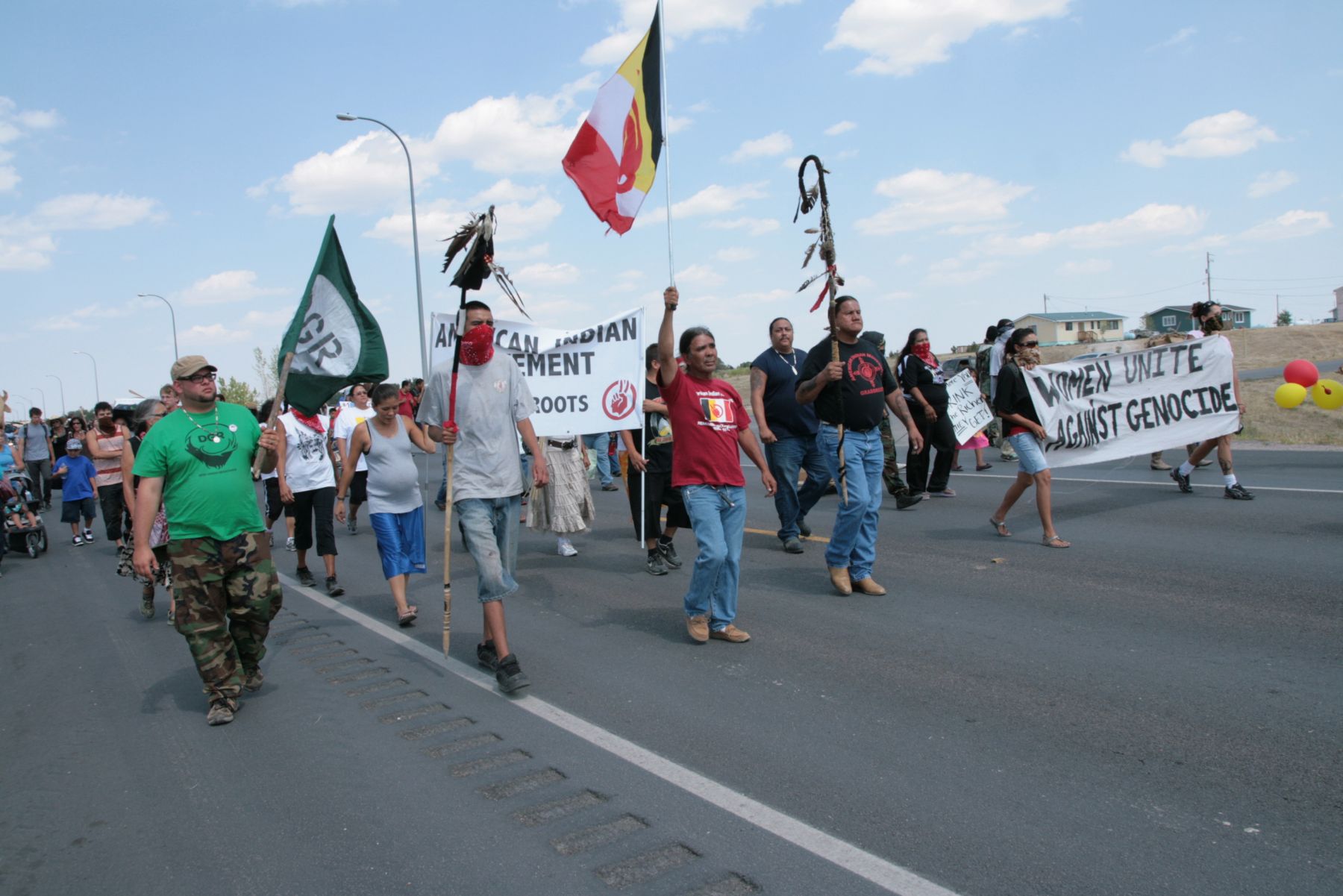
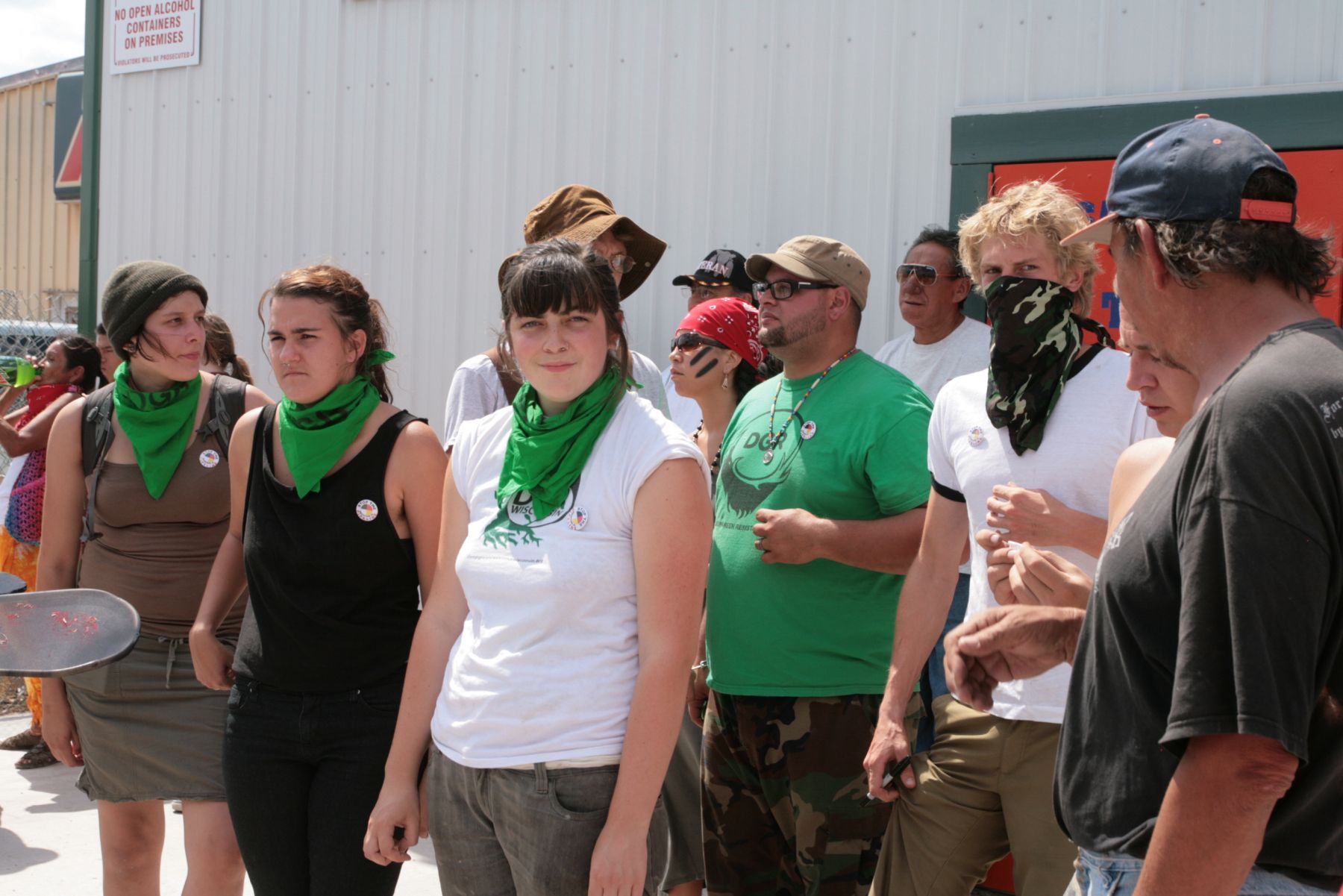
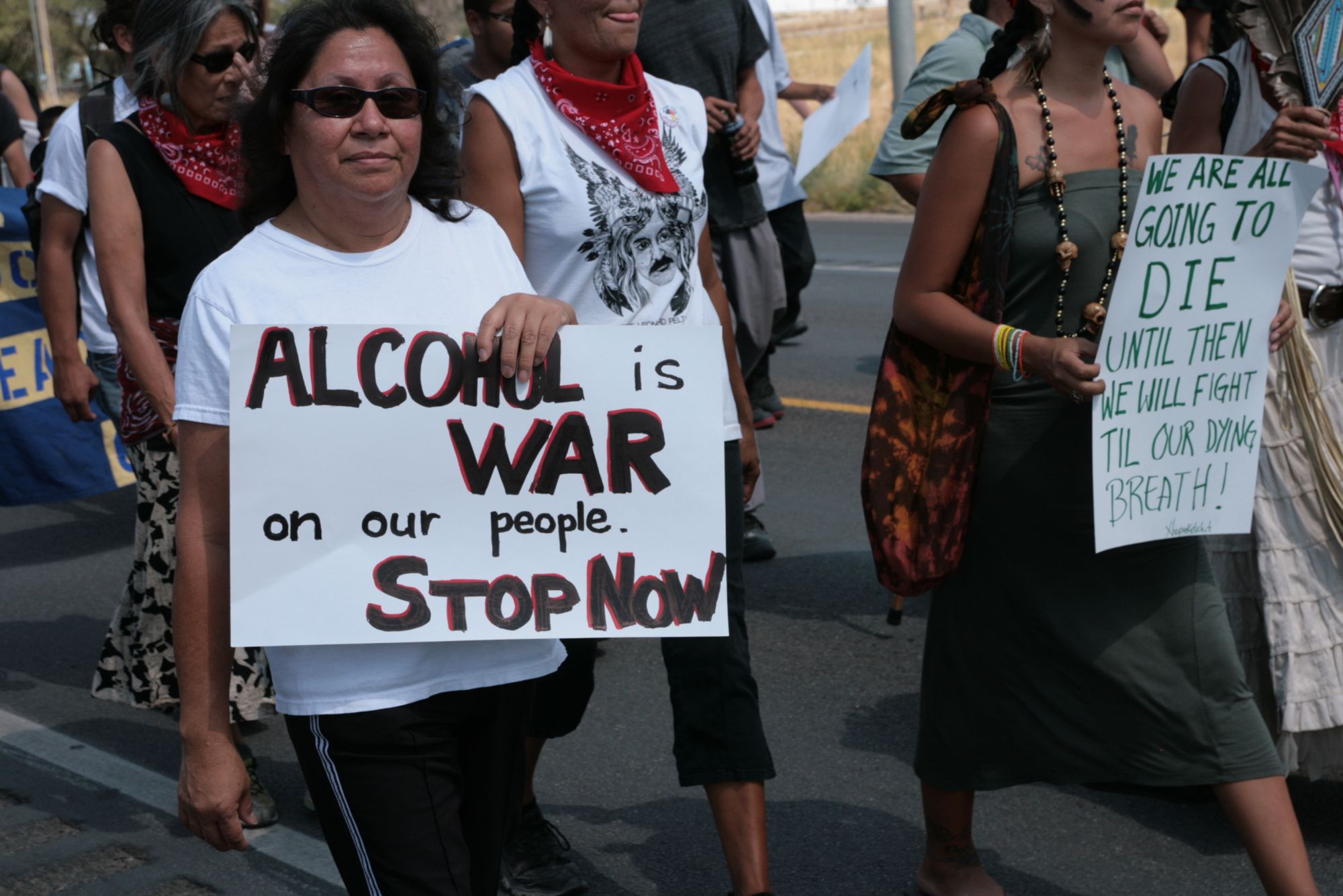
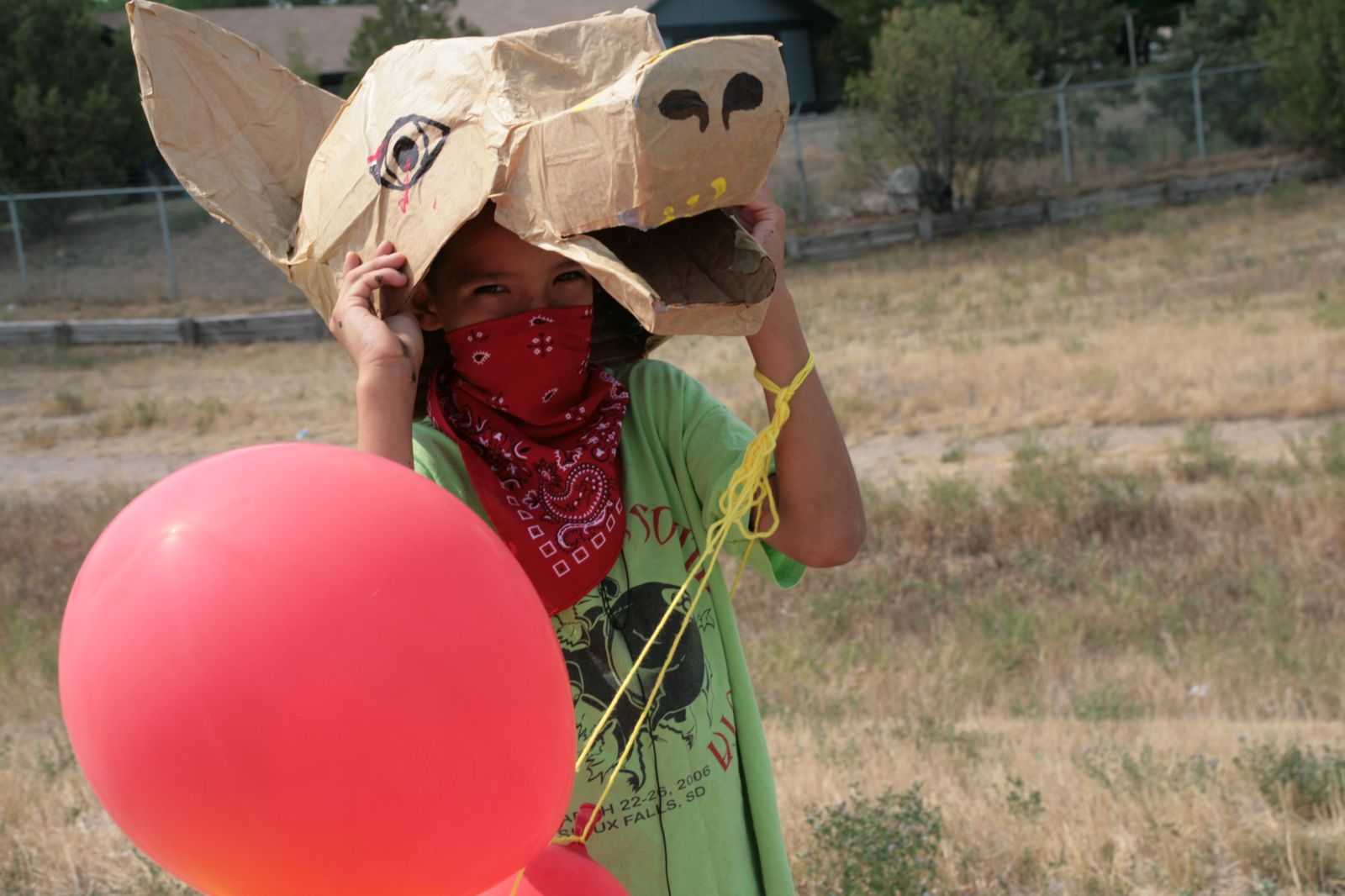
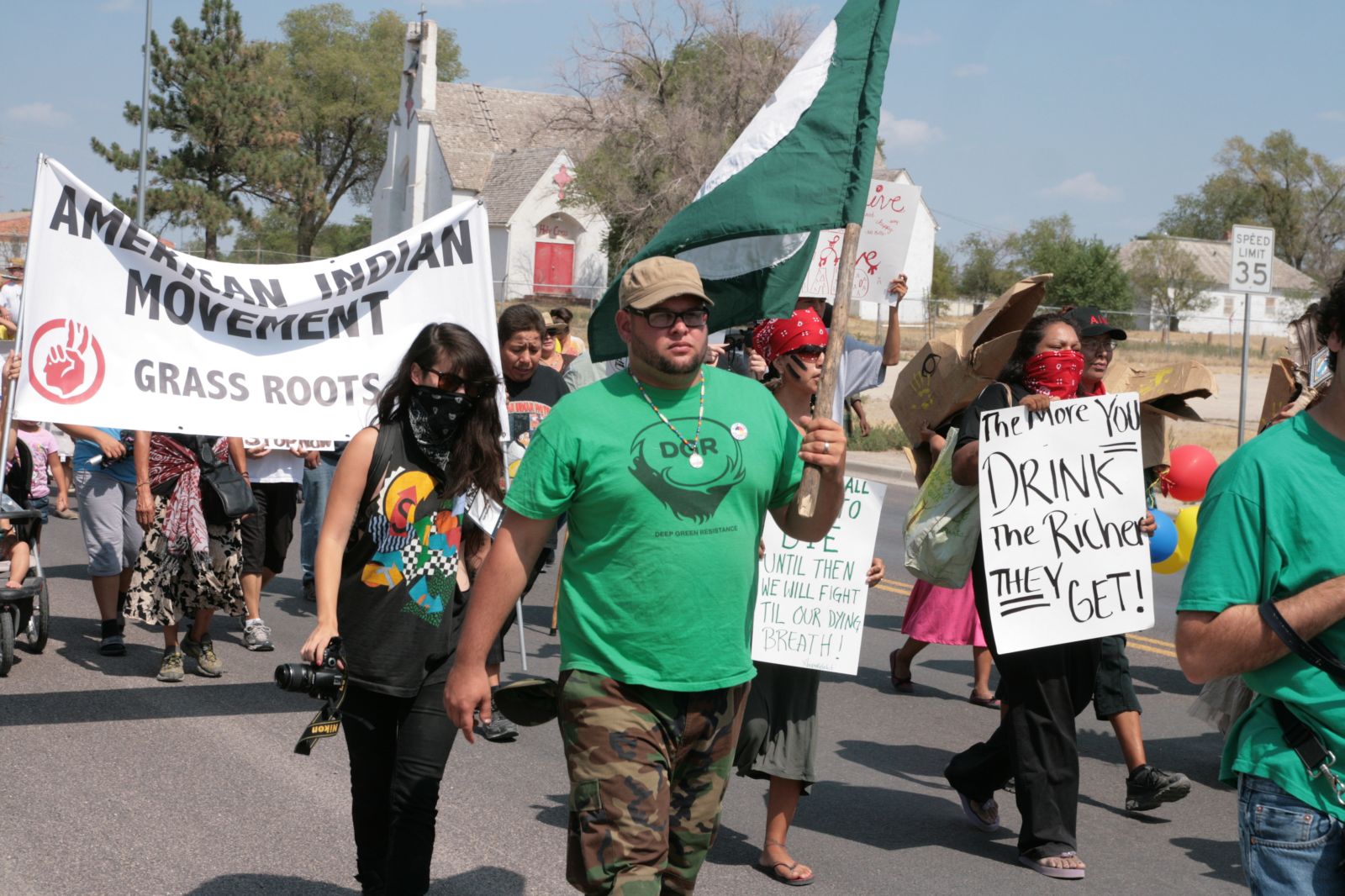
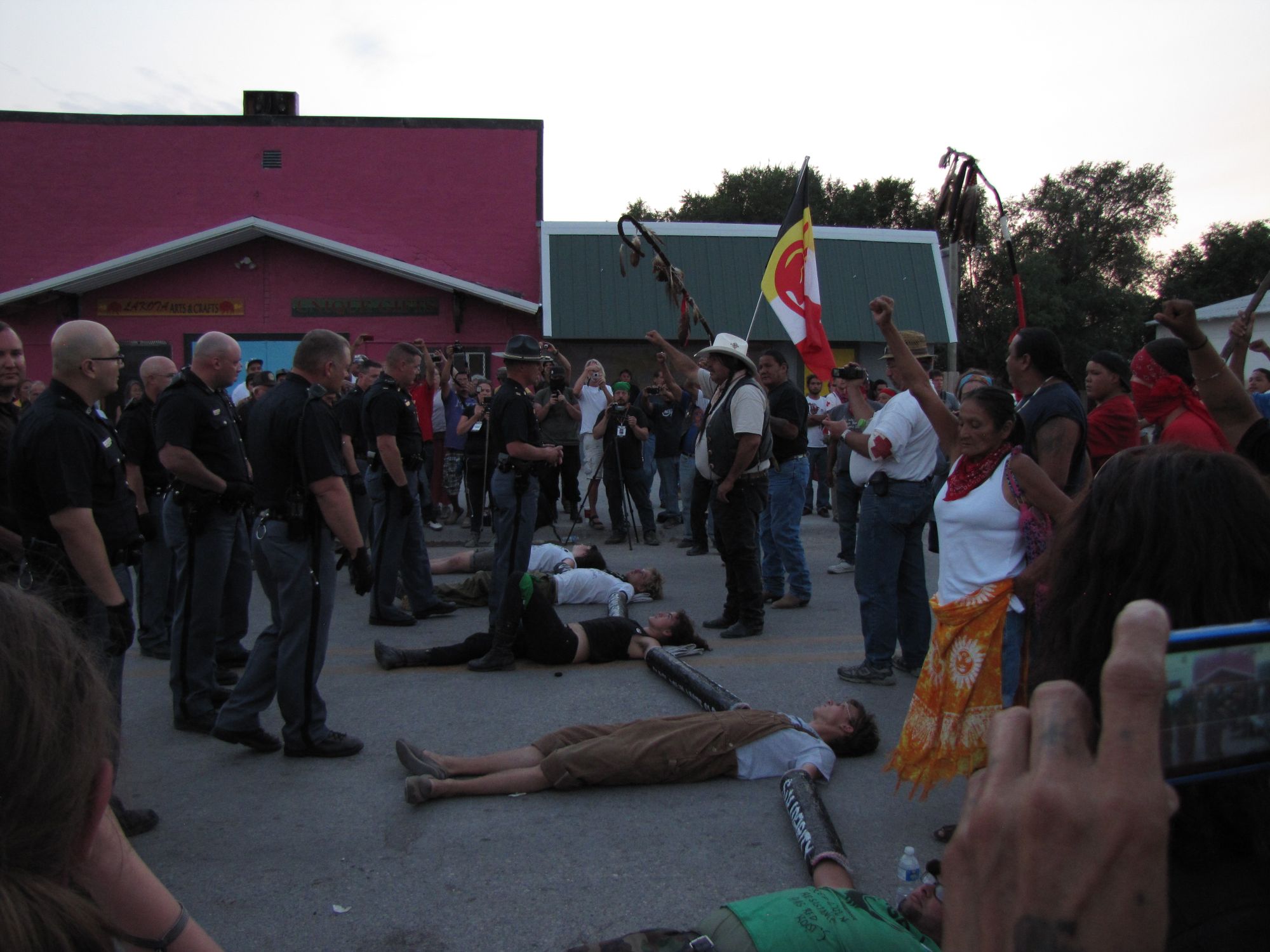

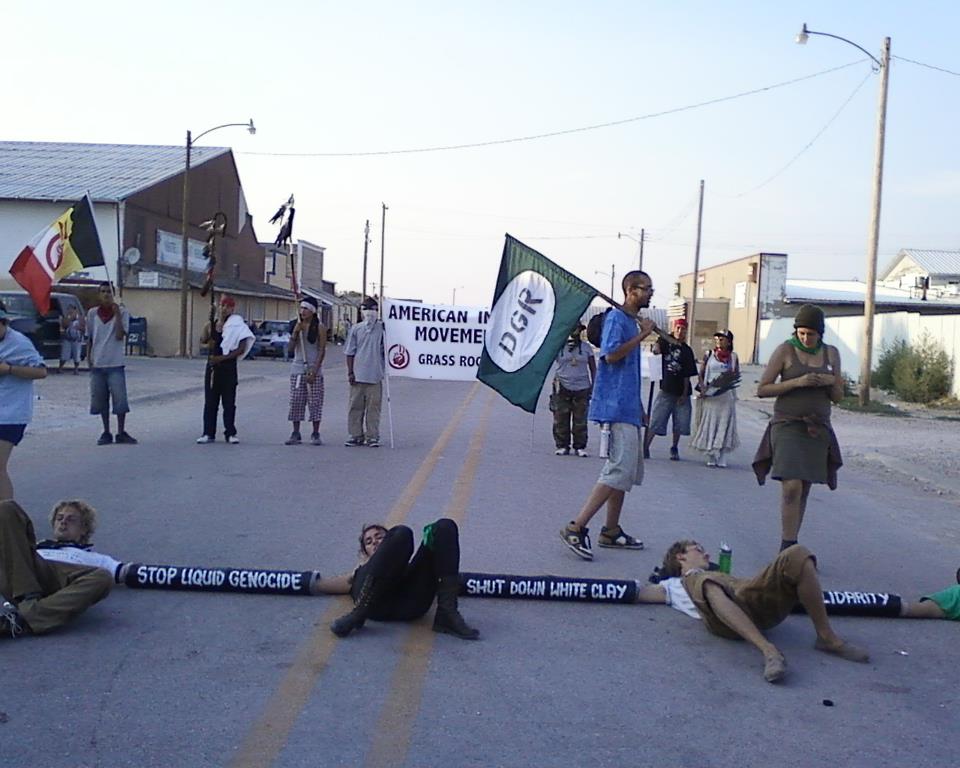
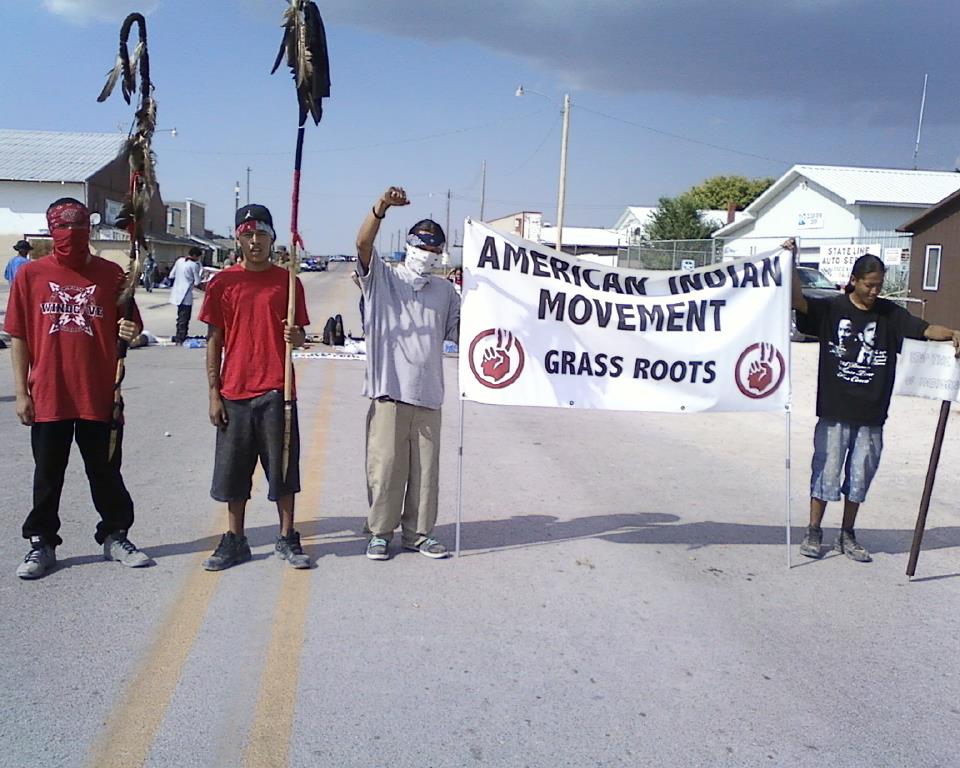
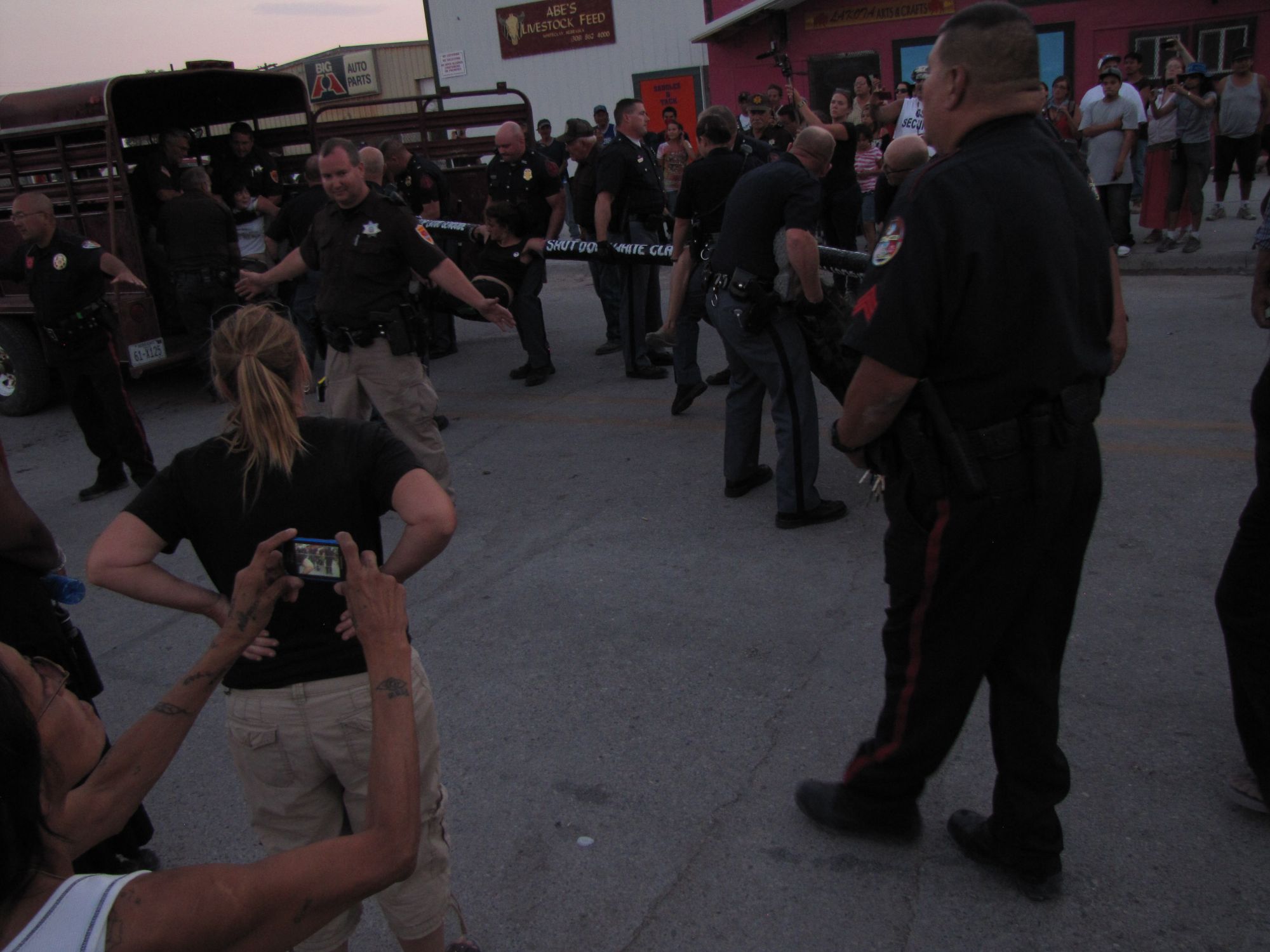
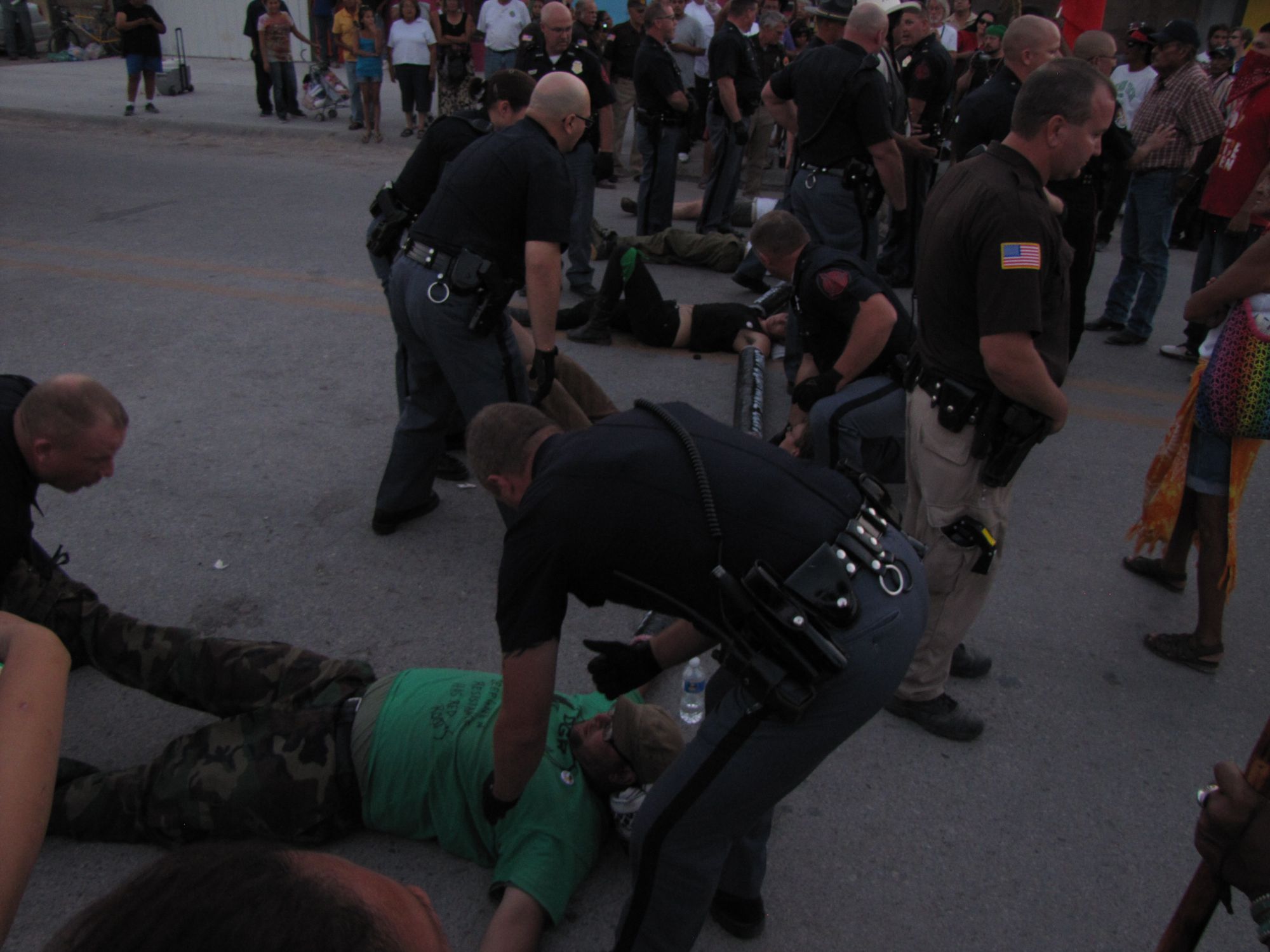



by Deep Green Resistance News Service | Mar 5, 2013 | People of Color & Anti-racism, White Supremacy
By Kourtney Mitchell / Deep Green Resistance
As a radical black male living in the most hegemonic culture to ever exist, I consistently find myself keenly aware of instances in daily life to recognize and critique white supremacy. I have experienced firsthand this culture’s systemic racism. From the racist and sexist police department which harassed and conspired against my mother while she worked for them, to the fairly routine instances of micro-aggressions, racial profiling and predatory business practices all people of color endure in this culture, I have a personal relationship with oppression informing my analysis of racism. So when whites accuse people of color of being unable to let go of the past, they are missing some critical considerations.
Many whites have a difficult time accepting any attempt to redistribute wealth and resources to historically oppressed classes because they fail to see the reality of life as a person of color in this society. And when our stories are silenced, the dominant narrative of this culture can proliferate.
So I want to speak directly to whites who honestly believe society is post-racial and that they are being oppressed. I want you to listen and try to understand if you can.
One of white supremacy’s more insidious aspects is that it has perfected the art of double-speak. While it appears you are saying society is post-racial and we are all equal now, and therefore any redistribution of resources to historically oppressed classes is reverse racism, what you are really saying is the comfort and safety which was a result of a historically privileged position in society as leech members of a parasitic class of people is being challenged, and that makes you uncomfortable.
You want to know what I mean with that statement. Dominant classes of people are parasites, because they feed on the oppression of others. Whether or not you realize it, if you are a member of a dominant class, you are benefiting from the oppression of another class.
As a man, I benefit from patriarchy and misogyny. Members of my class of people are leeches, and that makes me a leech as well. It is my responsibility as an aspiring male ally to women to constantly critique my own participation in this culture and to do whatever I can to deconstruct the sexist and misogynistic tendencies I possess from this culture’s indoctrination. That is the minimal task of an ally, and the same applies to whites who wish to ally with people of color to combat racism. You must first admit your complicity in it.
Whiteness is hegemony. To be clear, race does not exist inherently – it is a social construct with no basis in actual biology other than the melanin levels in your skin and its relationship to how your ancestors evolved on their preferred landbase. The creation of race was a direct result of the hegemonic tendency inherent in parasitic classes of people.
“White” is purported to be related to skin color and ancestry, but what is it really? A social class. If race is not actually real, then we must consider more real, tangible indicators of difference and their real effects on the material conditions of our everyday lives. When we search for other indicators, the most glaringly obvious one is privilege and access to resources. By far, without doubt, whites own more land and possessions, earn a higher income, and experience far fewer discriminatory experiences than people of color.
It is important to understand what it means to view racial oppression in the context of class analysis. Whiteness is a class experience, and not based in biological reality. But that does not mean one can just decide to stop being white, just like I cannot decide to stop being a man as long as the dominant culture classes me as a man. As long as you are classed as white, you will continue to benefit from white privilege. This is what allies need to remember.
The identity of persons of color serves the purpose of organizing through common cause. For my culture, black identity is about survival, not about superiority or a desire to exercise power over whites. It is a response to cultural genocide, an example of class consciousness as the starting point in combating oppression. As stated in Racial Formations in the United States:
Whites tend to locate racism in color consciousness and find its absence color-blindness. In so doing, they see the affirmation of difference and racial identity among racially defined minority students as racist. Non-white students, by contrast, see racism as a system of power, and correspondingly argue that blacks, for example, cannot be racist because they lack power.
When people of color are afforded opportunities on the basis of their skin color, this is not racism. It is redistribution of the privilege of access to resources, an attempt to even the playing field that is skewed towards whites.
If you think past racism has no effect on today’s reality, you are in denial. Your ancestors were given a huge head start because they were not enslaved and they did not suffer under white supremacist Jim Crow laws and murderous gangs of thugs in white sheets and hoods. They did not suffer under the tyranny of the White Citizen’s Council, or the 3/5 law, or the Fugitive Slave Law. They did not suffer under the Tuskegee Experiments, the Japanese internment camps, the ghettos and reservations and racist police departments.
To be white in this society is to start ahead, even if you are poor. The poorest white is still privileged in ways the middle class black person is not. Rich, wealthy and affluent blacks are still racially profiled and discriminated against in various ways.
The dominant narrative of this culture – that of the white patriarch – forbids redistribution of resources and privilege, because that would mean the empowerment of historically oppressed classes, affording them a little more ability to even the score. So this culture must adjust the narrative to encourage backlash against resistance to white supremacy, otherwise the narrative of the resistance will proliferate and threaten to turn the tide in our favor. So it convinces privileged members they are being discriminated against, and that they should not consider or listen to or even hear the stories of people of color, because goddess forbid you have your identity challenged for once. You cry reverse racism and deny the presence of the same tendencies of the past because you have never lived in our world.
Of course, redistribution of resources is not the end goal. We must ultimately bring down the capitalist, industrial infrastructure facilitating white supremacist oppression of people of color. We must permanently disable the control mechanisms of the culture – the police, the military and the media – because they all play a role in the subordination of people of color, the theft of their resources and the erasure of their cultures and stories.
A comprehensive anti-racist strategy includes a critique of civilization itself. It recognizes civilization as the interlocking systems of oppression inherent in infinite growth economies. It realizes the colonial, imperialist agenda of empires as being intimately connected to the white supremacist tendency, and as being the stumbling block to real autonomy and self-determination for people of color. And it relates the destruction of the natural world to the destruction of cultural diversity among human populations.
My people are being killed in the streets, incarcerated, enslaved and denigrated, and any analysis avoiding this reality is dishonest and immoral. If we are going to attempt to “speak truth to power,” we had better at least speak the truth, regardless whether or not people are ready to hear it. We do not have time to wait for people to “get it.” We needed militant action a hundred years ago. We are far into complete biotic collapse and continued genocide of non-white cultures. We must act now to rid the planet of this scourge and ensure it never returns.
by Deep Green Resistance News Service | Mar 1, 2013 | Alienation & Mental Health
By Ben Barker / Deep Green Resistance Wisconsin
“There is a problem. It’s a big problem. It’s not just the kids in the inner city. It’s the average middle-class family dealing with this and suffering huge losses.” The problem is heroin. The voice quoted here belongs to a local parent who just lost two sons after they overdosed on the drug.
I live in a relatively small, mostly white, and definitely conservative Midwestern city where this just keeps happening: kids are dying. Heroin has been seeping into my community for years now. Combined with an already existing culture of heavy drinking, and the addiction, poverty, and violence that almost always accompanies substance use and abuse, the result should be obvious: a new twenty-something-year-old face in the obituaries every week. They didn’t die because they were simply irresponsible or reckless; this crisis is built in to the dominant culture, and nothing will get better until this culture is changed.
We live in a society that values money above all else. Money comes before education, before healthcare, before children, before community. Decisions affecting all of us are made according to profit motive rather than human need. On every level, capitalism systematically exploits and destroys healthy communities.
The backdrop to this local heroin crisis is a repressive city that does little to serve young people or anyone besides the rich elites who run it. Social programs and initiatives are relatively nonexistent. Cafes, music venues, and other social spaces are denied funding so that they usually have an expiration date of less than a year. We’re left with only a few options: get a job, get high, or plan to move away. The gate-keepers of this community enforce a terrible double-standard: they won’t talk about their kids who are shooting up and dying, but they also won’t provide (or allow) an alternative.
Speaking of no alternatives, about one-third of this country’s population is living below the poverty line or near it. The rich keep getting richer and the poor keep getting poorer. The places hit first and hardest are what Chris Hedges calls “sacrifice zones.” These are the colonies of empire—the ghettos, the barrios, and the reservations. Like the grieving parent alluded, it’s not uncommon that “kids in the inner city” die young, because those communities were gutted—flooded with alcohol, gentrified, and stripped of social services—long ago. But now, the pillaging has come around full circle to take even the children of the “average middle class family,” the children of the elites.
The story is the same everywhere: when there’s nothing to live for, there’s no reason to care about living. Hopelessness is universal.
Last night I had a conversation with one of my peers who quickly moved from this town as soon as she was of age. In just one year, 12 of her hometown friends have died from heroin or drunk driving.
My childhood best friend, 20 years old, overdosed on heroin. A year later, his friend, also 20 years old, overdosed on heroin. A person I had a crush on in the 8th grade recently died after driving drunk. A person I used to go skateboarding with in high school recently died after driving drunk and smashing his car into a brick wall. I wish I couldn’t, but I could go on and on.
My heart breaks a little more every time a young person’s life is so needlessly taken because of the sad, sorry culture built by generations before us. From Palestinian and Pakistani children bombed to death, to the guns fired by gang kids, to the unheard cries of suicidal victims of bullying, to the cities mourning too many heroin-related deaths to count—the young did not design this cruelty, nor do we have much of a say in changing it.
We have only two choices: adapt or die.
Some people can’t adapt. They were born into a body that simply doesn’t allow it—one that is female, one that is not white. Even if members of historically oppressed classes want to adapt to this culture, they are always denied the status of full human beings. But the choice was never meaningful for any of us; you can only adapt to drinking poison for so long before it kills you as sure as it does anyone else.
Adapt or die. Deep in our hearts, young people understand the profound sickness we are being socialized into. There’s little to make us feel alive in this routine of school, work, die. Save suicide, how do you cope with that? Welcome to addiction. It can be drugs, alcohol, money, sex, or anything that will numb the pain of being trapped in desperation. We’re floating in a sea of despair, struggling just to keep our heads above the water of self-destruction, but all the while sinking into a pit of hopelessness and forgetting what it means to feel alive. Eventually, as was true for my friends no longer living, a person just gives up.
Before fizzling out, many will grasp for control by abusing whoever is nearby. But perpetuating cruelty will not save you from emptiness. Breaking boundaries is a habit that can only end in overdoses, alcohol poisoning, bullet wounds, and a short life devoid of anything resembling love.
Adapt or die. The only way out of a double-bind is to tear it down and start over. Conformity will not get us anywhere. There’s no shortcut to a life of meaning and integrity. And to get there, we have to choose not to adapt, not to die, but instead to resist. We need take back the humanity we’ve been denied.
Capitalism requires obedience. It needs good workers, good consumers, and good citizens, who have submitted our own wills and desires for the sake of “the way things are.” Sure, we might get a little rowdy once in a while, but as long as we don’t fundamentally challenge the system in which we’re trapped, nothing changes. Dead kids are of no consequence as long as they remain powerless to the very end.
Many from generations before us have chosen to resist this corrupt arrangement. But far too many more have not; they accepted the system as their personal savior, always willing to defend their conditions and never raise a finger or mutter a word in defiance. The result is a world of expanding sacrifice zones, which have now become so large as to subsume the youth of everywhere.
When asked why she was protesting the liquor barons preying on the Pine Ridge Indian Reservation, Lakota activist Olowan Martinez said, “Today I defend the minds of our relatives. Alcohol is a plague; it’s a disease; it’s an infection that causes our young people to kill themselves, to harm each other, to harm their own. We need to stop it before it’s too late. We came here to save the minds and mentality of our own nation.”
Young people today have no real chance of a future with good education, decent housing, and enough food or water. Moreover, we have no real chance of becoming who we are and who we truly want to be, no real chance of claiming the desires and dreams that are our birthright as sentient beings. The planet is burning, human societies are collapsing, and those in power are profiting from it all. It is our generation and those to come after that inherit this mess. We are living out an endgame and everything is at stake: life and all that makes life worth living.
Getting high will not make the horrors disappear. But until the horrors disappear, we can be sure that kids will keep getting high.
The youth have the most to lose, but we also have the most potential to turn things around. We can stop giving up our souls and, ultimately, our bodies, to this culture of despair. We can join with young people everywhere—from Palestine to Chicago, from Newtown to Pine Ridge—to let the powerful know that we will not be sacrificed for their profit. We will put down the drugs and put up our clenched fists. We will say enough is enough. We will not adapt and we will not die.
Beautiful Justice is a monthly column by Ben Barker, a writer and community organizer from West Bend, Wisconsin. Ben is a member of Deep Green Resistance and is currently writing a book about toxic qualities of radical subcultures and the need to build a vibrant culture of resistance.
